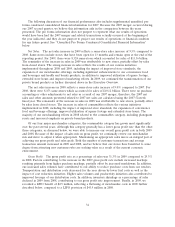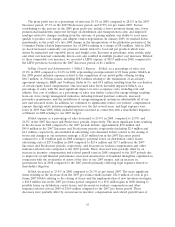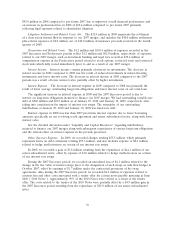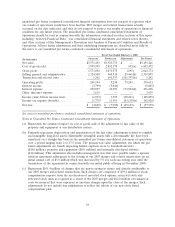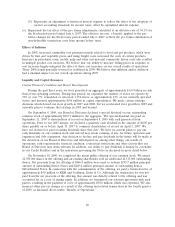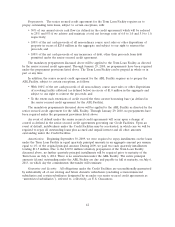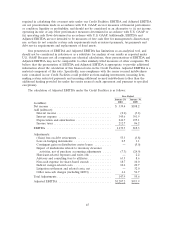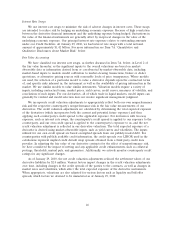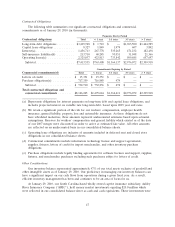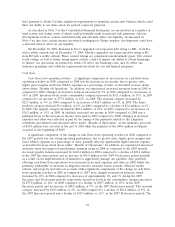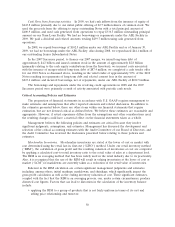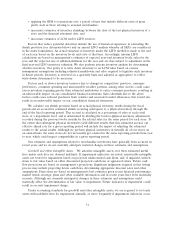Dollar General 2009 Annual Report Download - page 55
Download and view the complete annual report
Please find page 55 of the 2009 Dollar General annual report below. You can navigate through the pages in the report by either clicking on the pages listed below, or by using the keyword search tool below to find specific information within the annual report.Subordinated Notes (i) in cash, (ii) by increasing the principal amount of the Senior Subordinated
Notes or issuing new Senior Subordinated Notes (‘‘PIK interest’’) or (iii) by paying interest on half of
the principal amount of the Senior Subordinated Notes in cash interest and half in PIK interest. After
July 15, 2011, all interest on the Senior Subordinated Notes will be payable in cash. Through
January 29, 2010, all interest on the Notes has been paid in cash.
The Notes are fully and unconditionally guaranteed by each of the existing and future direct or
indirect wholly owned domestic subsidiaries that guarantee the obligations under our Credit Facilities.
We may redeem some or all of the Notes at any time at redemption prices described or set forth
in the indentures. We also may seek, from time to time, to retire some or all of the Notes through cash
purchases on the open market, in privately negotiated transactions or otherwise. Such repurchases, if
any, will depend on prevailing market conditions, our liquidity requirements, contractual restrictions
and other factors. The amounts involved may be material. In addition to the amounts repurchased in
connection with our initial public offering discussed above, we repurchased $44.1 million and
$25.0 million of the Senior Subordinated Notes in the fourth quarters of 2008 and 2007, respectively.
Change of Control. Upon the occurrence of a change of control, which is defined in the
indentures, each holder of the Notes has the right to require us to repurchase some or all of such
holder’s Notes at a purchase price in cash equal to 101% of the principal amount thereof, plus accrued
and unpaid interest, if any, to the repurchase date.
Covenants. The indentures contain covenants limiting, among other things, our ability and the
ability of our restricted subsidiaries to (subject to certain exceptions):
• incur additional debt, issue disqualified stock or issue certain preferred stock;
• pay dividends on or make certain distributions and other restricted payments;
• create certain liens or encumbrances;
• sell assets;
• enter into transactions with affiliates;
• make payments to us;
• consolidate, merge, sell or otherwise dispose of all or substantially all of our assets;
• designate our subsidiaries as unrestricted subsidiaries.
Events of Default. The indentures also provide for events of default which, if any of them occurs,
would permit or require the principal of and accrued interest on the Notes to become or to be
declared due and payable.
Adjusted EBITDA
Under the agreements governing the Credit Facilities and the indentures, certain limitations and
restrictions could arise if we are not able to satisfy and remain in compliance with specified financial
ratios. Management believes the most significant of such ratios is the senior secured incurrence test
under the Credit Facilities. This test measures the ratio of the senior secured debt to Adjusted
EBITDA. This ratio would need to be no greater than 4.25 to 1 to avoid such limitations and
restrictions. As of January 29, 2010, this ratio was 1.4 to 1. Senior secured debt is defined as our total
debt secured by liens or similar encumbrances less cash and cash equivalents. EBITDA is defined as
income (loss) from continuing operations before cumulative effect of change in accounting principle
plus interest and other financing costs, net, provision for income taxes, and depreciation and
amortization. Adjusted EBITDA is defined as EBITDA, further adjusted to give effect to adjustments
44


